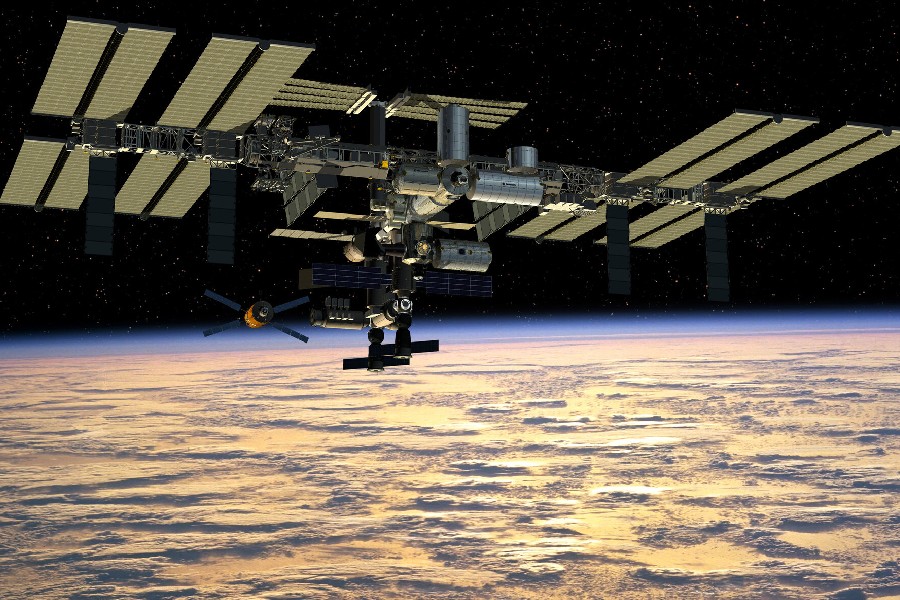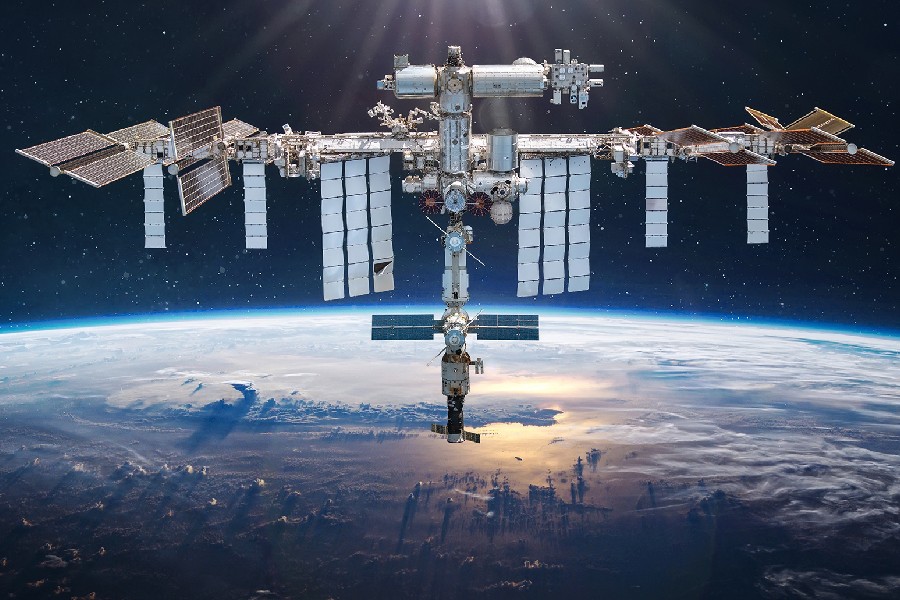The International Space Station (ISS) is one of humankind’s greatest achievements. This research laboratory orbits the Earth while astronauts and cosmonauts live and work on board. But with parts created and launched by over 15 countries, one question remains – who actually owns this $150 billion asset circling above us in space?
The ISS represents cooperation between countries that have disagreed on just about everything else. Even more interestingly, its various modules and equipment are owned by different nations.
Over the coming article, we will break down which countries contributed what components and infrastructure and who owns the ISS. We will also analyze what their ownership stakes mean in practical terms.
Does any one nation truly own this collaborative effort for the benefit of global knowledge and advancement? The answer may surprise you.

Who Owns the ISS?
So, who owns the ISS? The International Space Station (ISS) stands as a testament to collaborative exploration, owned not by an individual entity but by a synergy of space agencies: NASA, Roscosmos, ESA, JAXA, and CSA.
This celestial partnership, governed by the Intergovernmental Agreement (IGA), intertwines the scientific prowess of nations in a shared endeavor to push the boundaries of space exploration.
The ISS, a floating testament to global cooperation, underscores the belief that our collective journey into the cosmos is a venture that transcends borders and unites humanity.
The International Space Station – A Shared Cosmic Symphony
Multinational participants in the ISS project
The International Space Station brings together many nations for a common cause. The countries work together despite differences on Earth. Their shared goal is advancing science and technology in space.
The first agreements were signed in 1993. Five space agencies became original partners in the ISS project. NASA, Roscosmos, ESA, the Japanese Aerospace Exploration Agency (JAXA), and the Canadian Space Agency (CSA) lead key aspects. Additional nations have since joined as well.
Introduction to NASA, Roscosmos, ESA, JAXA, and CSA roles
NASA
The National Aeronautics and Space Administration represents the United States. NASA coordinates the program and contributes to most of the ISS modules. These include the Unity, Destiny, and Harmony modules. NASA also provides crew and cargo transportation.
Roscosmos
The Russian Federal Space Agency built key ISS systems. These include the Zarya module and the Zvezda service module. Roscosmos provides crewed Soyuz spacecraft for astronaut transport. Progress cargo craft keeps the ISS supplied with necessities.
ESA
The European Space Agency provided the Columbus laboratory module. ESA built the Automated Transfer Vehicle for cargo deliveries until 2014. It designs the service modules for NASA’s new crewed Orion spacecraft.
JAXA
The Japanese Aerospace Exploration Agency delivered the Kibo laboratory module. It includes a robotic arm and an outdoor experiment platform. JAXA developed the HTV cargo spacecraft used through 2020.
CSA
The Canadian Space Agency built the remote manipulator system known as Canadarm2. This robotic arm plays an integral role in ISS maintenance and operations. CSA will also contribute to an advanced lunar gateway robotics system.
The Cosmic Constitution – Intergovernmental Agreement (IGA)
The Intergovernmental Agreement (IGA) legally defines ISS cooperation. It entered force in 2009 after being signed in 1988. Amendments were made as new partners joined over time.
All ISS partners must follow the IGA. It ensures shared access based on contributions. The principles preserve rights to each module and component. But the full station operates collectively.
Key provisions ensuring collaborative management
The IGA allows universal use of the ISS. Research and exploration are intended to benefit all humanity. Nations have access based on their investments. But no one can deny another partner nation’s use of the ISS components.
Partnership in decision-making is another key aspect. The Multilateral Coordination Board meets regularly to guide ISS activities. Each agency has one vote on mission planning, utilization policies, and responsibilities for operating various systems.

A Celestial Melting Pot – Contributions of Participating Nations
NASA’s role and contributions
NASA leads overall coordination per the 1998 IGA. It contributed to the US Orbital Segment modules. These provide living quarters and science labs. NASA funds crew and cargo transport on US vehicles.
Key NASA modules are Destiny, Unity, Harmony, and Tranquility. The European Columbus lab and Japanese Kibo labs connect to the US segment.
Insights into Roscosmos, ESA, JAXA, and CSA contributions
Roscosmos provided the Russian Orbital Segment modules. These include Zarya in 1998 and Zvezda in 2000 for initial station assembly. Russian modules focus on propulsion and life support systems.
ESA built the Columbus for science experiments and observations. This module has an independent life support system but requires electricity from the US side.
JAXA’s Kibo is one of the largest ISS labs at nearly 40 feet long. It has a unique airlock and robotic arm to support experiments.
CSA’s Canadarm2 is essential for maintenance, inspections, dockings, and more. It moves crew members and payloads, and provides a mobile base.
Uniting Nations, Advancing Science
Collective goals of the ISS mission
The mission is a peaceful cooperation in space exploration. Goals include scientific discovery and preparing for travel deeper into space. Working together moves beyond conflict on Earth.
The microgravity environment advances research. Learning how humans adapt guides future long-duration space flight. Developing technology paves the way for inhabiting the Moon and Mars.
Scientific advancements achieved through international collaboration
The Alpha Magnetic Spectrometer analyzes cosmic rays. This particle detector could reveal anti-matter and dark matter mysteries. The device is too large for one nation’s module. Global teamwork enables transformational instruments.
Growing protein crystals helps develop new drugs. Cancer treatments are being researched on the ISS due to microgravity benefits. These medical goals depend on the full station capabilities.
The diversity of modules allows specialized research. Columbus studies our Sun. Kibo examines materials science and Earth observations. Destiny houses biotech and life science projects. All benefit humanity.
ISS Ownership – Beyond Borders and Geopolitics
Highlighting the spirit of global cooperation
The ISS represents humanity working to advance as one. 15 nations united to achieve impossible things alone. People and technology from around the world build understanding.
Differences fade in pursuit of shared dreams. All can access opportunities in space, propelling innovation. Partners ally for the greater good despite conflicts on Earth.
Emphasizing the significance of transcending geopolitical boundaries
The orbital outpost overlooks borders that divide humankind below. Research transcends the limits of the past, seeding progress. Astronauts symbolize rising above separation to a boundless future.
Components meshed in microgravity show unity through diversity’s strength. Ownership lies not in modules but in the freedom to reach new potentials. Together, all move forward for those who will one day live and work beyond the ISS.
A Journey Through the Stars – Key Milestones in ISS Ownership
Notable achievements in ISS ownership history
- 1993 – USA, Russia, Europe, Japan, and Canada sign agreements to collaboratively build a space station. This intergovernmental partnership is historic.
- 1998 – The Russian-funded, US-built module Zarya launches first. It provides battery power and propulsion vital for assembly.
- 2000 – The ESA-built Columbus lab is agreed upon. Research for the benefit of all nations will be conducted there.
Milestones showcasing the success of international collaboration
- 2011 – All major world space agencies have elements onboard. Cooperation transcends politics as ISS construction completes.
- 2015 – The One-Year crew mission is jointly conducted by Russia and the US. Long-term collaboration advances future exploration goals.
- 2020 – The space agencies agree to continue ISS operations until at least 2030. Support for joint missions in orbit reaffirms unity.
Conclusion
As we journey through the stars, the International Space Station guides the way – all of humankind is invited on this odyssey. Through the ISS, we realized that boundaries on Earth do not apply in space.
The station’s ownership and achievements demonstrate what nations can accomplish when working together to push frontiers. This orbital laboratory represents the best of humanity: cooperation, innovation, and the shared hope for a peaceful future.
Now that you know who owns the ISS, you can better appreciate the collaborative efforts of the space agencies of the world. ISS is not owned by one nation. Rather, it belongs to all countries and people willing to look beyond borders and participate in the missions it makes possible. This article helped elucidate how shared dreams can propel us to unite for the greatest good.
